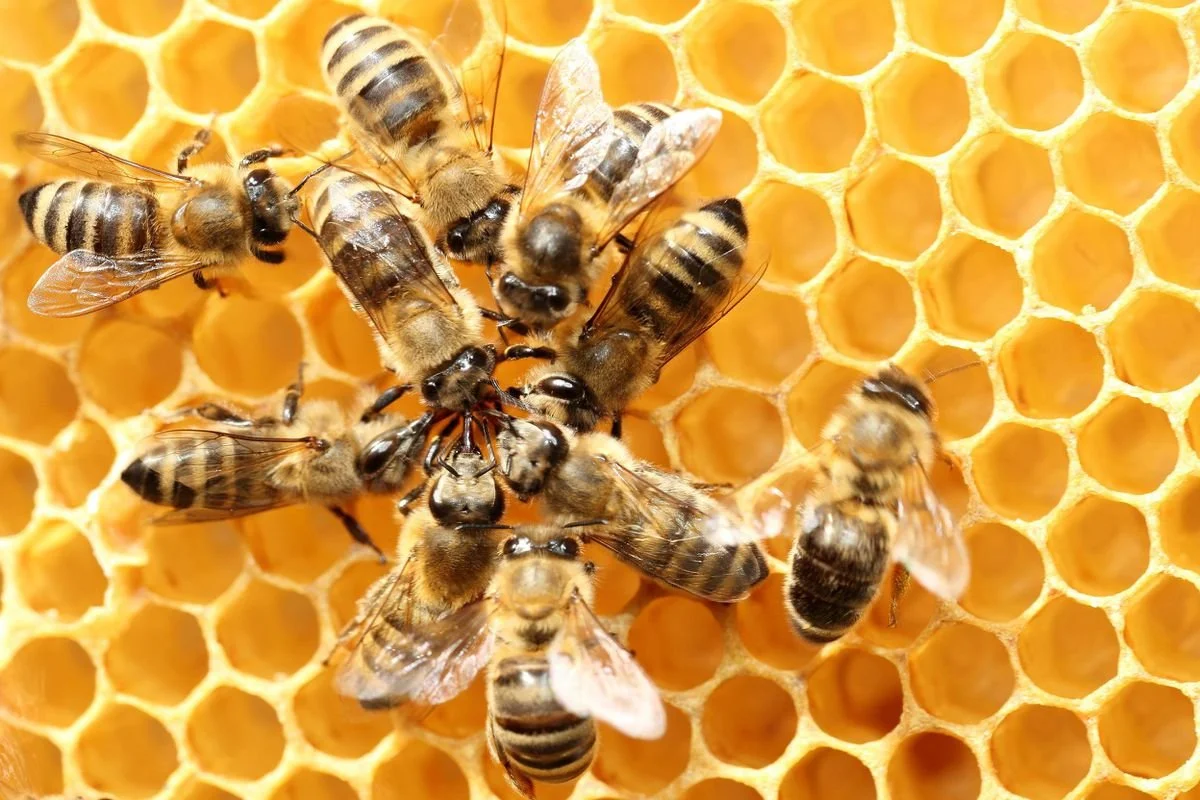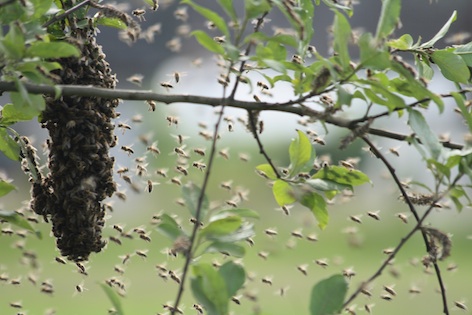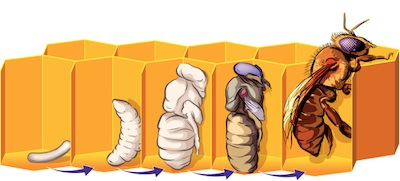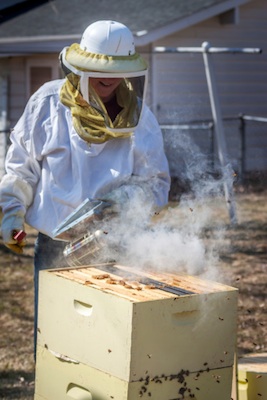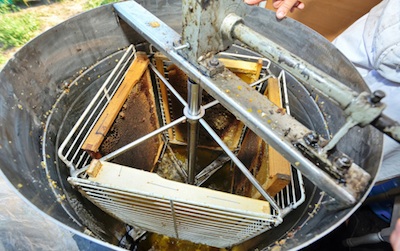Bees are insects.
They live in a hive.
Bees collect nectar and pollen from flowers.
Bees use nectar to make honey.
Bees use pollen as food for new bees.
Why are bees important?
Honey oozing from wax comb. ©Getty Images
Bees are very useful insects. They pollinate flowers, which makes fruit and seeds develop.
Without bees doing this, about three quarters of plants that we eat or our animals eat would not grow.
Bees make honey from the nectar they collect from flowers and keep it in wax storage cells to be their food in winter when there are no flowers and therefore no nectar to eat. There are different kinds of bee, but the European honey bee makes the most honey. They make more honey than they can possibly use, so humans are able to take the extra honey they make. These are the bees that are kept by beekeepers. There are many other kinds of bees around the world that do not produce this excess of honey, but still do the important work of pollination.
Bees are called social insects
This means they live in very organised groups called colonies.
A queen bee and a worker bee. ©Getty Images
A bee colony lives in a hive, has one queen, some drones and many workers.
The queen is the largest bee in the colony and she is the only one that lays eggs. Drones are male bees. They do not work or sting. Their only job is to mate with a queen bee so that she can lay eggs. Worker bees are female and do all the work. There are about 55,000 worker bees in a colony. Each worker bee has a stinger and uses it only in defence. If a bee stings another insect, it can keep on stinging. If it stings a mammal, such as a human, the stinger gets stuck in the mammal's thick skin and is torn off the bee, which then dies. The stinger keeps on stinging.
When a bee is between 12 and 20 days old, it develops a special gland that converts sugar from honey into wax flakes that appear on the outside of its abdomen. Bees collect these flakes from each other, chew it and use it to build hexagonal cells called comb. Comb is very thin but the hexagons make it very strong. The comb cells are used for keeping eggs, larvae and pupae, and for making and storing honey.
A bee with loaded pollen baskets on its legs. ©Getty Images
The jobs done by the worker bees
Workers do different jobs. It is totally dark inside the hive, and bees are almost deaf, so touch is the sense they rely on for communication. Workers do complicated dances to give messages to each other, such as where there are flowers full of nectar.
Only the queen lays eggs, and out of each egg a larva (a small grub) hatches, and each is put into a comb cell. Some workers feed the queen and the larvae. Larvae are fed bee bread, a mixture of honey and pollen. Other workers guard the entrance to the colony's home, which is called a hive. They cool it by fanning their wings.
Wild bees and their hive. ©Getty Images
Some of the workers collect nectar to make honey. Nectar is a sweet liquid in the centre of a flower. To reach it, a bee brushes against the part of a flower that produces a yellow powder called pollen. Pollen sticks to the bee's hairy legs and body before it flies to another flower of the same kind. Pollen from the first flower gets mixed with the pollen of the second flower. This keeps happening as the bee goes about from flower to flower. This mixing of pollen must happen so that seeds and fruit develop. This is how bees help plants and humans.
Some pollen remains on the bee, which brushes it into a space on two legs called pollen baskets, and this is mixed with nectar so it sticks. The nectar that the bee collects is stored in its honey stomach.The bees take the pollen and nectar to the hive. They give it to other workers who fill the cells of the comb with nectar, then seal the top of each full cell with a wax lid. Inside the cell, the nectar becomes honey.
Life Cycle of bees
Like other insects, a bee life cycle is egg, larva, pupa, adult. Each egg is placed by worker bees into a wax cell, where it hatches. The larva remains in the cell and is fed by the worker bees. After a few days it pupates, which means it goes into a sleep-like state while it changes into an adult. The adult bee emerges from the cell ready to work.
Bee life cycle: egg, larva, pupa, adult. ©Getty Images
Producing a Queen Bee
A swarm of bees ©Getty Images
A two-day old larva is fed with different food from the other larvae, a special food called royal jelly which makes it develop into a queen bee, with a large body that has the ability to lay eggs. After eleven days, the queen is fully developed and comes out of her cell. She flies out of the hive, followed by the drones. She mates with about 18-20 drones, which will give her enough sperm to last her lifetime, nearly two years. Sometimes a queen will return to the hive and replace the queen that is there, but at other times she will fly away accompanied by a number of worker bees to form a new colony.This is called a swarm. A queen starts to lay eggs about ten days after mating, and lays about 3,000 eggs a day. She never leaves the part of the hive where she lays eggs, and a group of workers looks after her.
Honey for Humans
An apiarist smoking the bees before opening the hive. ©Getty Images
A beekeeper is called an apiarist (say ape-ee-uh-rist).
Apiarists keep bees in hives with rows of frames inside. The bees build comb inside each frame and fill it with honey. The frames are easily lifted out and the honey-filled comb is removed and the empty frame replaced. The bees build more comb and fill it with nectar.
Some apiarists put their hives in places where there is plenty of one kind of flower, such as lavender or eucalypts, so that the bees collect nectar from only those plants. Honey made from nectar of certain plants has a particular taste. Most honey sold in shops is from a mixture of flowers.
A frame being taken out of the hive. ©Getty Images
An apiarist wears protective clothing, including netting that covers the face and neck, and fills the hive with smoke so the bees get sleepy. This makes it safer to open the hive. The combs are put into a container that spins around to remove the honey, leaving empty wax combs which can be used for making furniture polish or candles. Honey is taken from the container and put in jars. In a factory, the same process happens, but on a larger scale.
The combs are spun to remove the honey. ©Getty Images
It’s a good idea to get information from more than one source!
http://www.bees4kids.org.uk/fun-facts-about-honey-bees/
https://kids.kiddle.co/Honey_bee
Read many bee facts, including facts about wild bees native to Australia:
https://brisbanekids.com.au/bee-facts-for-kids/

